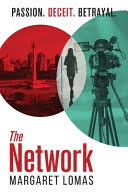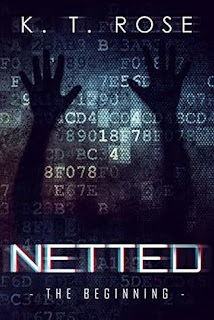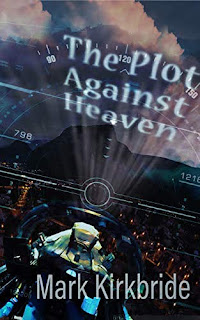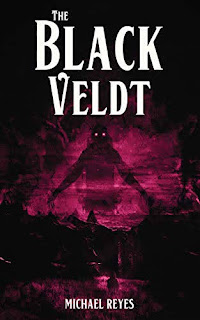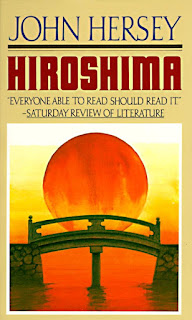Classics Corner: Hiroshima by John Hersey; Terrifying and Heart Wrenching Account of Life During and After The Nuclear Bomb
By Julie Sara Porter
Bookworm Reviews
PopSugar Reading Challenge: A book set in Japan (host of the 2021 Summer Olympics)
Spoilers: On August 6,1945 a bomb was dropped onto Hiroshima, Japan and the world as we know was changed. It was a nuclear bomb. WWII ended and the Atomic Age began, not with a whimper but a bang.
Over 100,000 people were killed by the blast and many more succumbed to the long term effects of radiation sickness. To this day, the village is surrounded by shadows of the people who had been vaporized.
In what was considered one of the biggest news stories of the 20th century, the nuclear attacks on Hiroshima and Nagasaki still are controversial. Should the Americans have dropped it? Were the Japanese going to surrender without it? Would it have saved a ground combat? What can't be denied is that it was a truly monstrous act that resulted in far more casualties, far more civilian casualties, than any other battle in the war.
In 1946, reporter John Hersey was commissioned to write a series of articles for The New Yorker on the impact of the nuclear attack. The articles proved to be so powerful that instead of splitting them,the editors of the New Yorker devoted their entire August 31, 1946 issue to Hersey's coverage. Ignoring the usual talk of the town, theater listings, short stories, and biting popular culture reviews, The New Yorker had one letter to their Readers: " TO OUR READERS. The New Yorker this week devotes its entire editorial space to an article on the almost complete obliteration of a city by one atomic bomb, and what happened to the people of that city. It does so in the conviction that few of us have yet comprehended the all but incredible destructive power of this weapon, and that everyone might well take time to consider the terrible implications of its use. The Editors."
Hiroshima was later published in book form by Alfred A. Knopf. Hersey's article was designed to get people talking and talk they did. His descriptions of the attack are nightmare inducing because unlike many nightmares, it happened. Hersey reported what was seen and somehow that makes the actions so monstrous that people have the power to create and use such weapons of mass destruction on real live human beings.
Hersey's descriptions of the events are incomparable, mostly because he did not resort to emotion. He told the events like they were, figuring the story was enough to move the Readers. Here is the moment of the blast from one of the eyewitnesses, Dr. Terufumi Sasaki: "(Dr. Sasaki) was one step beyong an open window when the light of the bomb was reflected, like a gigantic photographic flash, in the corridor. He ducked down on one knee and said to himself as only a Japanese would, 'Sasaki gambare! Be brave!' Just then (the building was 1,650 yards from center), the blast ripped from the hospital. The glasses he was wearing flew off his face; the bottle of blood crashed against one wall, his Japanese slippers zipped out from unde his feet-,but otherwise thanks to where he stood,he was untouched."
As any good writer does when covering a real-life event, Jersey personalized the Hiroshima attack, giving the atrocious events human faces to go with such a tragedy. He told of the attack from six civilians recounting their lives before, during, and after the attacks. Each of the six attributed his or her survival to chance. Hersey wrote, "Each of them counts many small items of chance or volition-a step taken in time, a decision to go indoors, catching one streetcar instead of the next-that spared him. And now each knows that in the act of survival he lived a dozen lives and saw more death than he ever thought he would see. At the time, none of them knew anything."
The six are:
Rev. Kiyoshi Tanimoto-A pastor of the Hiroshima Methodist Church, he was in the process of moving religious items via handcart. He was concerned about bombings in the area as well as raids. He and a colleague stopped at a rich man's house in Koi when the blast hit. Tanimoto cowered behind some large rocks in the garden and missed the impact.
Mrs. Hatsuyo Nakamura-A Tailor's widow and single mother of three, Nakamura and her children were exhausted from the various air raids in which they ran for shelter. Nakamura let her children sleep in rather than prep them for another one. At the moment of the explosion, Nakamura looked out the window to see her neighbor tearing down his house because it was in the way of an air-raid-defense fire lane. She took a step away from the window just as the flash filled the sky and her daughter called to her.
Dr. Masakazu Fuji-A prosperous doctor, Fuji saw a friend off the night before. His large home was often visited by patients and their family members. On August 6, Fuji only had two staying with him. He sat cross legged, reading the newspaper, when he saw the flash. As he rose, he saw the hospital which he lived near topple and sink into the river below.
Father Wilhelm Kleinsgore-a German priest of the Society of Jesus, Kleinsgore was in frail condition. He had been ill and the war time rations did very little to restore him to good health. He began his daily service when a siren ended it prematurely. He breakfasted with the other Fathers and then retreated to his bedroom to read. He lost his mind after the blast and could only remember wandering around the mission vegetable garden in his underwear.
Dr. Terufumi Sasaki-A young Red Cross surgeon affected by a nightmare and a sleepless night, considered calling in. He decided to take an earlier streetcar than originally scheduled. He drew blood from a patient and took it to the lab just as he saw the flash. As Dr. Sasaki wandered the halls, he realized that the patient that he tended had died as did a colleague with whom he had just spoke. In fact, Dr. Sasaki was the only doctor unhurt by the explosion.
Toshiko Sasaki-No relation to Dr. Sasaki, Miss Sasaki was a clerk in the personnel department East Asian Tin Works. She attended a memorial service for a former employee, a local Navy man who committed suicide. Miss Sasaki returned to her office and turned away from the windows just as the bomb hit. Miss Sasaki was near a large bookcase when the ceiling and floor above her collapsed. The bookcase next to Miss Sasaki toppled over, pinning her to the ground and breaking her leg.
The book is filled with various moments of intense fear and terror, mostly because of a populace that was unaware of the true impact of what had attacked them. They were used to traditional air strikes and bombs, but this was different. This had the power to destroy in less than a few seconds and no one was prepared. No one was warned that they would be attacked by a new weapon or what the impact could be. The true cruelty was revealed that one side had a massive weapon that they willingly used on another side that had no concept of what had hit them.
After the bomb hit, the book tells of the devastation which faced the six people. These paragraphs are heart wrenching as they wander through a once bustling city now filled with fallen and burning buildings, dead and injured bodies, and a miasma that filled the sky above them. There are moments that are meant to break the Reader's heart in reading the devestation such as when Tanimoto is given a child by an injured mother and carries the child to a makeshift hospital which is already filled with fifty or sixty wounded people. He later helped rescue 20 other people on a sandpit.
What parent wouldn't feel the anguish as Nakamura tries to wade through the debris to rescue her entombed children? Hearing their voices and unable to reach them is every parent's worst nightmare.
There is also salvation even in the midst of confusion. Even though Kleinsgore was still in a confused daze amid all the destruction, he managed to act. He saved the lives of a woman and her daughter who were trapped inside the catechist's fallen house. He too helped tend to the fallen with Tanimoto and helped the Nakamura Family leave.
Dr. Sasaki also exhibited a lot of courage as one of the few uninjured doctors on duty at his hospital. He took fresh bandages and tended to those who were nearby. He had no system. He just worked on as many as he could from those who had minor injuries to those at the point of death. Hersey compared his actions to those of an automaton working on as many people as he could without eating, sleeping, or stopping to rest.
There is sheer terror as Hiroshima's residents were caught in situations where every move could have killed them. Fuji and others were trapped on a bridge with fire approaching from every side. Rather than burn to death, they sought refuge in the water below. Fuji eventually returned to his home badly injured and in deep pain.
Miss Sasaki was also caught in an awful situation. Laying underneath the book case, she waited in intense pain for rescue as her leg became festered with pain and gangrene. She eventually was rescued by friends who assumed that she had died.
Because of the scant news and the immediate destruction that surrounded them, it was several days before the residents of Hiroshima learned that another nuclear bomb dropped on Nagasaki. During that time and Japan's surrender the people just waited to recover, unable to get the destruction out of their minds. Tanimoto remained at a nearby park tending to wounded and trying to locate other's families. Nakamua lay in a shelter with her frightened ill children. Fuji received assistance for his injuries that he tried to treat himself at home. Kleinsgore continued to help the wounded, including Fuji and the Nakamura.
Dr. Sasaki took a much deserved rest and began the process of identifying friends and family. He also began to recognize the symptoms of what would be identified as radiation sickness. Miss Sasaki languished in a hospital bed in pain knowing that she was soon going to lose her now useless leg.
Despite the enormous loss of life, the six people featured in Hersey's book were among the survivors. They suffered from immediate hardships in the days following the bomb. Hersey told us: "Miss Sasaki was a cripple. Mrs. Nakamura was destitute. Father Kleinsgore was in the hospital. Dr. Sasaki was not capable of the work he once could do. Dr. Fuji had lost the thirty-rook hospital it took him many years to acquire and had no prospects of rebuilding it. Mr. Tanimoto's church had been ruined and he no longer had his exceptional vitality. The lives of these six people who were among the luckiest in Hiroshima would never be the same."
Even though they survived, the six suffered from severe physical and psychological illnesses afterwards. They became the hibakusha- "explosion affected persons." Destitute, Nakamura continued to work as a seamstress to support her children despite having constant fatigue and abdominal pain. A severe bout of illness forced her into hospitalization and to sell her sewing machine to pay the cost. Nakamura carried a sense of passivity and acceptance to her fate. She managed to deliver bread and various other jobs before working in Suyana Chemical factory. Nakamura worked at Suyama for thirteen years, retired at 55, and lived with her children. In 1975, she fell ill during the flower festival.
Dr. Sasaki continued to be haunted by the bombing and the wounded. He continued to work at the hospital while working on his doctoral dissertation on appendiceal tuberculosis. He married during the stressful time after the bombing to a woman described as more sensible than he. At the hospital, he removed keloid scars from patients which returned. Sasaki and his colleagues had no literature about atomic survivors so they had little to go on.
In 1951, Sasaki quit the hospital and set up a private clinic. In 1963, Dr. Sasaki needed surgery on his lungs. The attending surgeons found cancer on his left lung and one of the blood vessels into the lung cavity gave way. He suffered severe hemorrhaging which almost killed him. Due to his near fatal illness and his wife's death in 1972, Dr. Sasaki decided to help the elderly and built a new clinic for that person.
Kleinsgore suffered from fever, diarrhea, and wounds, and exhaustion. His body was weakened but he continued to have a seflless spirit. In 1948, he was named priest of a larger church. He was so devoted to his adopted country that he became a Japanese citizen and legally changed his name to Father Makoto Takakura. He continued to have health problems including a low white blood cells, severe joint pain, and A-bomb cataracts. Finally in 1961, he retired from the church citing ill health. In 1976, Takakura slipped on an lcy patch and was hospitalized. He fractured his eleventh and twelfth vertebrae and became bedridden. He read the only two works that he said never lied-The Bible and timetables. Despite being nursed by his fellow priests, Takakura died.
Miss Sasaki adjusted to her injury, but was forever mentally scarred from the ordeal. She became the guardian of her orphaned brother and sister. She ended an arranged engagement in which her parents set before the war. Kleinsgore was a frequent visitor and tried to convert her to Catholicism. In 1947, Miss Sasaki placed her younger brother and sister into an orphanage and began working as an attendant. She ultimately transferred to another orphanage where she worked for six years, finding her calling.
Eventually she underwent three operations to restore her leg. They eventually became equal in length even though she felt pain for the rest of her life. In 1957, she converted to Catholicism, took her vows, and became Sister Dominique Sasaki. Sister Sasaki became director of a home for seventy older people and remained in charge of the home for twenty years. One of her gifts was to help people die in peace, probably because she experienced so much death during the attacks. In 1980, she was honored for twenty five years as a nun.
In 1948, Fuji built a new clinic on the site of the old one. He performed operations on keloids, appendectomies, and and treated sounds and took on venereal cases. He suffered no physical illnesses from radiation, but psychologically he was greatly affected. He tried to live for his pleasure principle. He took on hobbies like dancing, photography, golf, and billiards and drank to excess. He acquired a reputation as a playboy. In 1963, Fuji attempted suicide. On January 25, he fell into a coma and remained in a vegetative state until his death 11 years later.
Tanimoto had difficulties restoring his church without fundings. He visited the Methodist Board of Missions in the United States to solicit funds. By the end of 1949, Tanimoto raised ten thousand dollars for his church. He also established the Hiroshima Peace Center Foundation in New York to receive American funds for the city. Years later, those plans came to fruition with the Peace Memorial Museum and Peace Memorial Hall. After a second trip to the United States, Tanimoto created a Bible class for young girls affected by the blast and asked the city governments for funds to give them plastic surgery. He became something of a celebrity appearing on talk shows and You Bet Your Life (where he shook hands with one of the Ebola Gay pilots.) Later in life, Tanimoto was devoted to peace and disarmament. He lived long enough to see the Cold War and the United States and Soviet Union stockpile nuclear weapons, many of them worse than the ones that hit his home town.
Hiroshima gives an unflinching look at the consequences of war. It gives human faces to the people that some may think of as the enemy. Most of all, it reminds Readers that the enemy can sometimes be ourselves when we fail to account for the sufferings of others.

